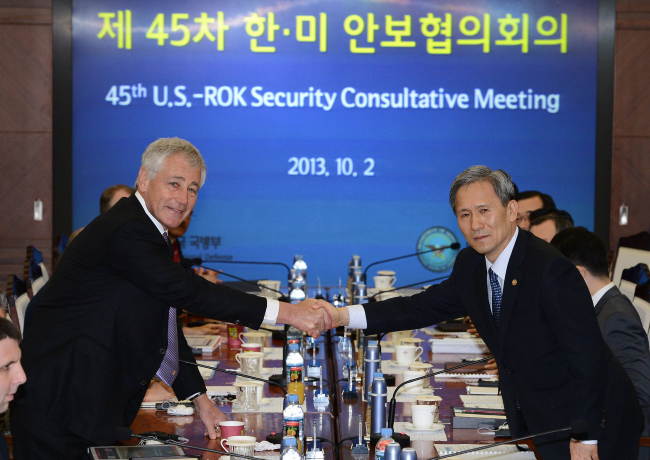South Korea and the U.S. on Wednesday left open the possibility of a delay in the transfer of wartime operational control during their annual defense talks in Seoul, saying consultations would continue based on their fresh evaluation of “conditions.”
“Our discussions have been ongoing and will continue to be ongoing regarding the OPCON transfer. And it has been conditions-based,” U.S. Defense Secretary Chuck Hagel told a press conference after the allies’ Security Consultative Meeting.
“I am very optimistic we will have an agreement on those conditions and we will get to where we need to be on the OPCON transfer,” the Pentagon chief said, noting that Washington took the issue “seriously.”
Apparently suggesting that Seoul was nearing the capabilities to retake operational control, Hagel pointed out that the South Korean military had become “stronger, more professional and capable” over the last decade.
The allies are expected to decide if or when the operational control transfer would occur in the first half of next year, a Seoul official said, declining to be named.
During the SCM talks, Defense Minister Kim Kwan-jin and Hagel decided to launch a joint working-level group over the possible rescheduling of the transfer, which is currently slated for December 2015.
Last May, Kim requested the allies reconsider the timing of the transfer in light of increased nuclear threats from North Korea that conducted a third nuclear test in February following its successful launch of a long-range rocket last December.
A senior Seoul official said currently the crucial conditions for the OPCON handover were South Korea’s capabilities to counter the North‘s nuclear and missile threats.
During their meeting, Kim and Hagel also formally endorsed the bilateral “Tailored Deterrence Strategy” against North Korean nuclear and other weapons of mass destruction.
The strategy offers a strategic framework for tailoring deterrence against key North Korean nuclear threat scenarios both during peace and wartime, and strengthens the integration of allied capabilities to maximize deterrence, Hagel explained.
It puts forward specific diplomatic and military procedures for three stages ― threat, impending attack and attack ― which officials say would also involve an option to eliminate Pyongyang’s WMDs before an attack.
For these procedures, the allies are to mobilize all available assets across all domains including space and cyberspace. The strategic assets include U.S. stealth bombers, nuclear submarines, intercontinental ballistic missiles and core intelligence and surveillance systems such as military satellites, sources said.
On the issue of missile defense, Hagel stressed interoperability of the allies’ militaries.
“We are working with the ROK on their missile defense system and these don’t have to be identical as long as they are interoperable,” he said to a reporter’s question of whether Washington asked Seoul to join its global MD program.
“We want systems that work together and this involves a lot of command and control, which is complicated. This is a significant piece of deterrence capabilities to meet the threats North Korea increasingly poses to the ROK and the U.S.”
During the SCM, the defense chiefs also endorsed the allies’ military-level tentative accord to virtually retain the main functions of the Combined Forces Command, which is to be dissolved following the OPCON transfer.
Under the deal, a South Korean general is to lead the Combined Theater Command ― the envisioned command structure ― while a U.S. general will become its deputy chief. The approval came as they concurred their troops operating under separate chains of command would impede operational efficiency.
Also during their talks, Hagel reaffirmed that despite Washington’s financial woes including the congressionally-mandated spending cuts, or sequestration, and the government shutdown, the U.S. would continue to maintain the current level of 28,500 U.S. troops here to ensure combat readiness.
“We will adjust and are adjusting now and we have to adjust. But our focus, interest and commitment to our allies will remain the same. We always adjust our resources to match our priorities and we will continue to do that,” he said.
The allies also agreed to step up their cooperation in the realms of space and cyberspace.
By Song Sang-ho (
sshluck@heraldcorp.com)





![[Exclusive] Hyundai Mobis eyes closer ties with BYD](http://res.heraldm.com/phpwas/restmb_idxmake.php?idx=644&simg=/content/image/2024/11/25/20241125050044_0.jpg)

![[Herald Review] 'Gangnam B-Side' combines social realism with masterful suspense, performance](http://res.heraldm.com/phpwas/restmb_idxmake.php?idx=644&simg=/content/image/2024/11/25/20241125050072_0.jpg)
